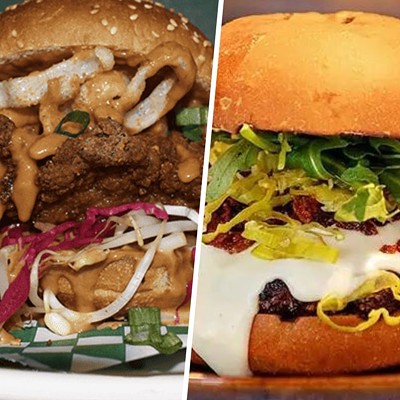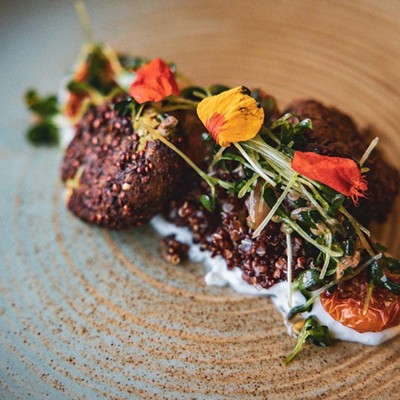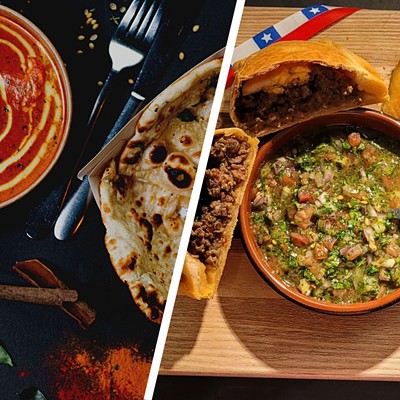It's been two years since 21-year-old Jessica Budgell has sunk her teeth into a morsel of filet mignon. "What meat did I eat when I ate meat?" she says. "Roast beef, ribs, ham, bacon, chicken, salmon, cod, trout...everything!" But when it comes to the ideology of meat-eating, the now-lacto-ovo vegetarian isn't as far from meat advocate Jennifer Scott as you might guess.
Budgell is secretary of the Halifax Association of Vegetarians (an old Halifax organization re-thought and revived at an annual general meeting in April). She says the association focuses on educating people on the benefits of vegetarianism and the negative health and environmental impacts of eating meat. It doesn't deal with animal welfare or concerns already on the radar of other groups. Budgell, who eats no meat and only a few free-range eggs, and drinks milk and eats cheese only if a friend or eating establishment doesn't offer an alternative, says being a vegetarian for her "isn't about solving all the world's problems. It's about creating a balance. That's what I think vegetarianism is. It's creating awareness and it's making people think about the food they eat and the impact that it has."
When it comes to the nuts and bolts of opposing meat-eating, Budgell's main concerns centre around the problems of large-scale farming and industrialization—the same things the Ecology Action Centre's Jennifer Scott, and Soil and Crop Improvement Association president and dairy farmer Andrew Grant work to turn the tide against.
"People don't understand farming," Grant says, "and they industrialize it."
Industrialization is a catch-all term and can include monoculture (repeatedly growing only one kind of crop which degrades soil quality and increases reliance on chemical fertilizers), corporatization (where profits go to centralized head offices rather than being dispersed back into small communities) or, simply, bad environmental practices. (One example: having many animals and no annual crops on a farm means lots of manure with no fields for it to be used as fertilizer. The excess manure must be collected and disposed of or it has the potential to build up and be carried by runoff into drinking water sources and waterways.)
Industrialization is, at root, a lack of sustainability.
Budgell has other beefs with industrialized farming and the meat it produces, too. "Animals are pumped up with hormones and antibiotics," she says. (That's often to keep them from getting sick in the face of all that excess manure from farm concentration.) "We're becoming resistant to antibiotics because we've been taking them in regularly through our diet."
And primary among Budgell's concerns is the vast amount of energy needed for artificial ventilation and lighting, and mechanized production on large, industrial farms. "Right now the global greenhouse gas emissions generated by the livestock sector are 18 percent. That's more than transportation, which is, I think, 13.5."
She thinks? She's right. The UN Food and Agriculture Organization, whose 2006 study Livestock's long shadow says industrial animal rearing is "one of the top two or three most significant contributors to the most serious environmental problems, at every scale from local to global."
There's worse news still: The report's authors say the global demand for meat is expected to more than double by 2050.
So what about meat in Nova Scotia?
We eat our share of industrially farmed meat, and raise our share of it, too.
Genuine Progress Index Atlantic, a non-profit society which conducts research measuring environmental, economic, social and wealth factors in day-to-day life, is in the process of measuring the ecological footprint of every Canadian province.
An ecological footprint is a way of measuring resource consumption and waste production and it's expressed in hectares per person. Globally, there's 1.8 hectares available for each of us; Nova Scotians use up about eight hectares each. You read correctly—we're using up more than four times what's available or sustainable.
GPI Atlantic executive director Ron Coleman says Nova Scotia's food footprint is almost one third of that total eight-hectare footprint. That's not meat alone, of course, but, Coleman says, "meat has a bigger ecological footprint than grain. That's just the reality."
The solution?
Smaller-scale, sustainable farming, Budgell says, would lessen the impact of farming on the environment. "Do you know the term "externality'?" she asks.
Externalities. Well, let's just come out and say it: they're not that exciting. But they're crucial to the concept at hand. Externalities are all the parts of the food production process that aren't given a price.
Ask yourself: How does a Jos. Louis snack cake cost less than a quart of locally grown organic strawberries?
The strawberries grow in a field year after year. They are tended by farm workers, picked, shipped and sold. There's more to it than that and I want no part in denigrating the hard and complex work of organic farmers, but, basically, you know, those are the fundamentals.
The Jos. Louis contains 30 ingredients (at least, I think—it's difficult to tell precisely with all those parenthetical "contains" notations, plus what does "modified milk ingredients" mean? Why the plural? Is that one ingredient, or five? Or 10?). The Canadian-made chocolate snack cake requires scores of machinery and countless hands to run those machines. There are managers and middle managers and CEOs to pay. There are delivery drivers. There is the energy needed to run the factory—to light it and heat it and run the conveyors and the packagers and the big machine that squeezes the goop into the middle of the Jos. Louis. There's advertising. There's store display paraphernalia. And there's the energy needed to transport all the ingredients to the factory in Montreal and from there to the farthest reaches of North America.
One Jos. Louis snack cake from the corner store: $1.19
Quart of in-season, local, organic strawberries from the Halifax Farmers' Market: $4.50.
So how's that now?
That's externalities. The buyer of the Jos. Louis doesn't pay the full cost of her treat. The Jos. Louis eater doesn't pay for the cost of cleaning up the greenhouse gas emissions her snack cake produced on its journey from Montreal to Halifax. The Jos. Louis eater doesn't pay the small community in, say, Saskatchewan, for the damage done to acres and acres of farmland because the fields have been used for too long to grow one crop—wheat, for flour, the number two ingredient in a Jos. Louis. (Try to guess ingredient number one.)
Get it? The earth is a constant in the economic equation determining the $1.19 price of a Jos. Louis. The price of a Jos. Louis doesn't inflate if there's a chemical spill that Montreal's Vachon (owned by Saputo Bakery Inc.) must clean up. Likewise, the price doesn't drop if the company works toward sustainably managed land and clean water. Nothing like that is given a price. That's externalities. And that's a big part of the problem with industrialized farming.
Comparing a Jos. Louis to strawberries is like comparing apples to oranges, you say?
Fine. Compare strawberries to strawberries. It works the same.
That quart of locally grown organic strawberries from the Annapolis Valley costs more than a quart of conventional California strawberries for the same reason—the California strawberries are priced without the externalities.
The local strawberries reflect the true cost.
"When you work within a local economy," Jessica Budgell says, "externalities are considered because it's small scale. So, the people who are producing it make the price according to everything, including what it takes for them to clean up the mess that they make."
In the end, yes, the price is usually higher, but, "there's going to be less environmental degradation" (not to mention more local economic prosperity because wages are generally adequate and the money ends up getting dispersed back into the local community). Taking the externalities into account means the local strawberries are actually cheaper in the end.
But most people don't get that. They can't get past the shelf tag on their food to see how a lower grocery bill costs them more in the end.
"If you support the local system," explains the EAC's Jennifer Scott, "you're supporting the people and the environment and you're trying to get the balance back. And that's why, if you're going to go buy local organic meat from a farmer in the Annapolis Valley, that's great. But if you don't know that those choices have implications, then you're not going to do it, you're going to go buy the cheapest thing at Superstore."
Learning the implications and making choices based on that knowledge may be getting easier. Farmers' markets are hot right now and Halifax's is getting bigger and better with its new location on the Halifax waterfront expected to open next summer with (mercifully, regular market shoppers will testify) some vendors selling seven days a week.
Even in its current beautiful-but-cramped quarters, the Halifax Farmers' Market is no slouch. The Market (the oldest continuously running market of its kind in North America) recently won the hearts and admiration of a research group with the Slow Food Foundation for Biodiversity, headquartered in Florence, Italy. David Szanto called the Halifax Farmers' Market "a model for what farmers' markets can evolve to, given the will and administrative savvy" and "one of the preeminent farmers' markets across two continents and a half-dozen countries."
At a recent meeting of the Prince Edward Island ADAPT council, a pro-environment farm support organization, speaker Mark Winne, of the US Community Food Security Coalition, sent the message that he believes the local food label will soon become as important as organic.
As Jennifer Scott says, "I woke up one morning and all of a sudden local food is hip.
"Can I say there's a hunger for it?" she says laughing. "I think there's a hunger for a connection with the land. I like to think people want to support local growers and local communities, that they want to decrease their food miles to help curb global warming, for the health of themselves and their children and the health of the land."
But there are still barriers.
Most Nova Scotians shop at big chain grocery stores (see the main story, "Green meat," on page 16 for a run-down of the challenges in getting local food there) and ultimately, until full-cost accounting of food production externalities is routine—that is, until we pay the real cost of our Jos. Louis and those quarts of strawberries from California—there will be an economic incentive for the average shopper to favour (often without realizing it, or realizing there's even a choice) industrialized farming methods, farm amalgamation and farm concentration.
With all this working against them, Jennifer Scott says, Nova Scotia farmers who turn away from small-scale farming operations aren't to blame.
"It's pretty bloody hard to have a viable farm," she says. "I don't want to be critical of farmers because it's a hard job. And they make decisions based on just trying to make a living. So I can understand why a lot of growers have moved in an industrial direction."
In an ideal world, Scott says, farmers' work would be valued and they'd be compensated adequately when they sold their products. They wouldn't have to compete with the real estate market for land.
"You can't just decide to be a farmer," Scott says. "You have to have a mentor. You need good working soil. You need well-designed barns. It's a complex vocation.
" we've already lost so many. If we lose more the whole infrastructure is going to come unravelled. And it's not just infrastructure, it's culture, it's people, it's knowledge that's evolved over generations."
This is the third part of this issue's special meat package by Lezlie Lowe.
















